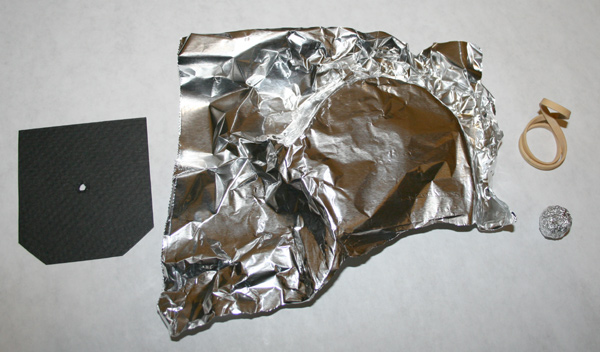Make a digital pinhole camera for free?

Make Magazine's blog post headline "$0 digital pinhole camera" sounded too good to be true, and guess what? It is! Poster Jason Striegel acknowledges that he "stretched the $0 part a bit" but even setting aside the fact that you need an actual dSLR camera for the project (which costs actual money last time I looked), unless you plan to beg, borrow, or steal the black construction paper, aluminum foil, rubber band, and tape you'd need, that will cost more than $0 as well. Still, the idea is an interesting one for photography buffs.
What photo enthusiast doesn't think back fondly on the old home-made pinhole cameras crafted from a shoe box, or better yet, a Quaker Oatmeal box? A pinhole camera is essentially a light-proof box with a small hole for the aperture rather than a lens. Besides being a super-simple camera that you can build at home, the main benefit of a pinhole camera is that because the aperture is so tiny, you can capture a very wide depth of field where all objects (from background to foreground) are sharp and in focus.
Striegel's version uses the body of your dSLR as the light-proof box, allowing you to use the sensor as your exposure surface. The post is an interesting read--he even suggests a way to jury rig your camera to take the very long exposure you need with such a small aperture to avoid the additional cost of a remote shutter--but he skips over an essential issue: if you want your photos to be in focus, the size of the pinhole has to be specific relative to the focal length (i.e., the distance to your sensor). There's a good online calculator that a commenter points out (plus a lot of other good info on making pinhole cameras).
Other commenters actually suggest better DIY pinhole/dSLR tips, such as using the body cap that came with your camera and drilling a hole in that, and using sheet copper or the metal from an aluminum can to make a more precise (i.e., less jagged) hole which will result in sharper images as well. See instructions for just such a project on Photocritic.org.
Of course, if you're not a build-it-yourselfer (and are willing to spend more than $0), you could always get a precision-drilled body cap at The Pinhole Resource, or if you have a recent Lensbaby with interchangeable optics, you could get this pinhole optic. And, finally, if you're a Olympus fan, note that the new Olympus E-620 and E-30 include a Pinhole art filter among their special effect filters.
Have you gotten good results with a DIY pinhole setup? TalkBack and let us know.
[Via Make: Blog]
